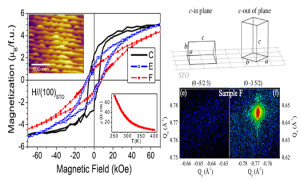Functional properties
Functional Properties
Strain-Induced Effects
[slideshow_deploy id=’666′]
The properties of thin films can be engineered by using structural strain imposed by the substrate. In complex oxide materials as pervoskites, this means that strain may effectively modify the overlapping of 3d cation and 2p oxygen orbitals thus, modifying hopping integrals and bandwidth. Our interest lies on the study of the influence of residual strain and relaxation mechanisms on the magnetotransport properties of high quality epitaxial oxide films.
Magnetic anisotropy
[slideshow_deploy id=’708′]
Magnetic Materials with perpendicular magnetic anisotropy (PMA) are of great interest as they offer a plethora of possibilities for the implementation of new high density magnetic random access memories. Torque measurements are performed to determine the anisotropy constant and the anisotropy field and to enlight the physical origin of PMA in thin films.
Interfacial effects
[slideshow_deploy id=’667′]
The high level of sophistication reached by the thin film growth techniques makes possible the fabrication of heterostructures of complex oxides with atomically sharp interfaces where interesting new phenomena have appeared allowing envisaging the possibility of developing new devices. New functionalities may emerge due to the interplay of charge, spin and orbital degrees of freedom at the interface of dissimilar materials. We investigate the role of interfacial effects in the electronic and magnetotransport properties of manganite-based heterostructures with different architectures. For this goal, we maintain a close collaboration with Dr. Sergio Valencia from Helmholtz-Zentrum-Berlin für Materialien und Energie.
Tunneling Anisotropic Magnetoresistance
[slideshow_deploy id=’712′]
Tunneling anisotropic magnetoresistance (TAMR) reflects the dependence of the magnetoresistance of MTJs on the orientation of the magnetization of the electrodes with respect to the crystallographic axes or the current flow direction. This angular-dependent contribution is due to the coupling of orbital and electronic spin degrees of freedom. Since TAMR-based devices can operate with only one magnetic electrode they could be an alternative of much easier technological implementation than conventional MTJs. Our interest in this field is investigating new materials with strong TAMR response.
